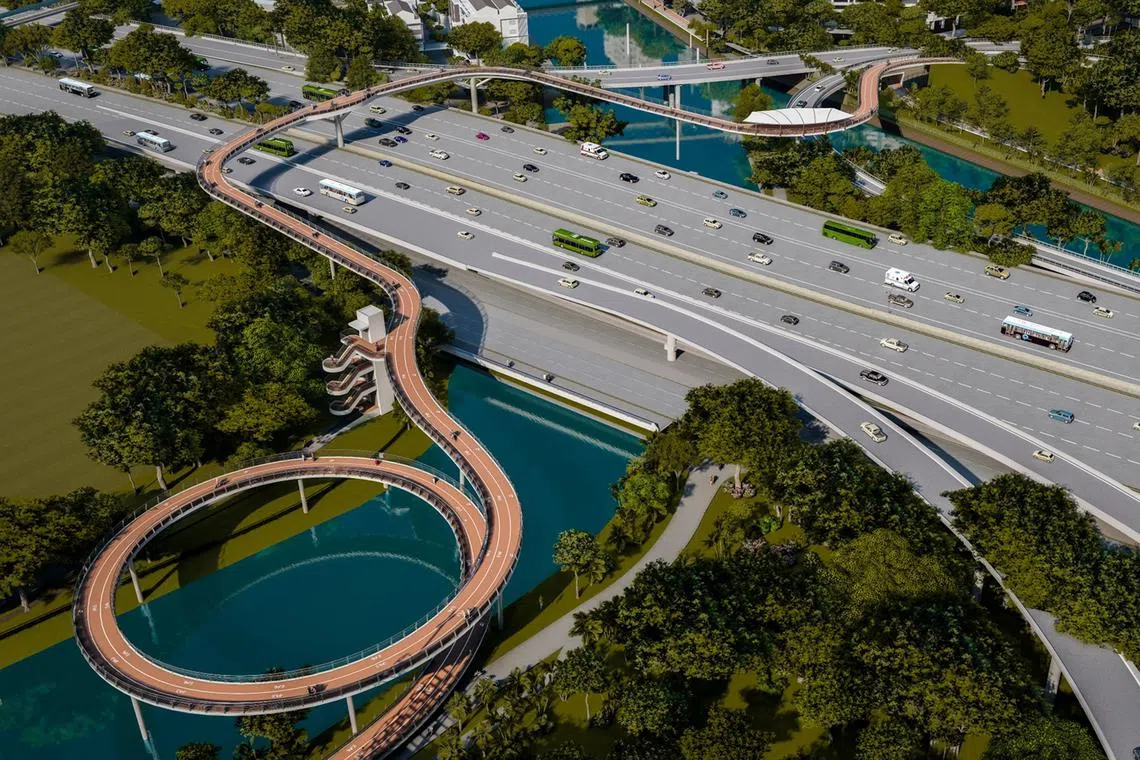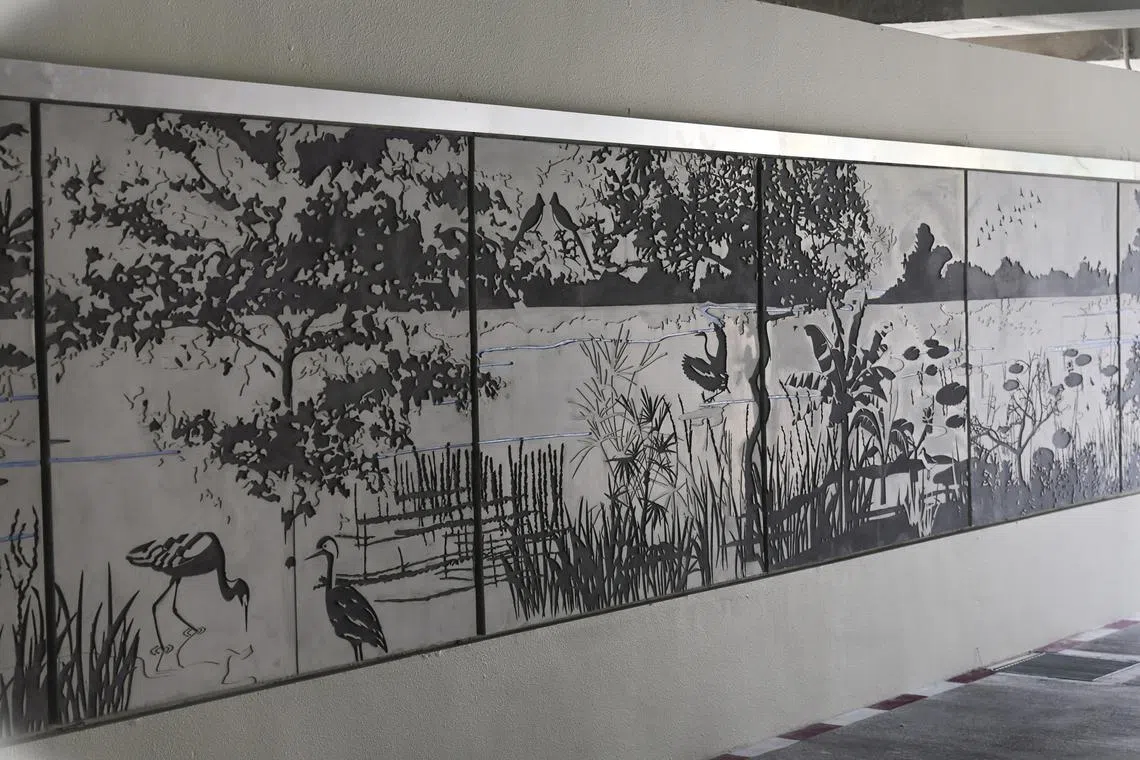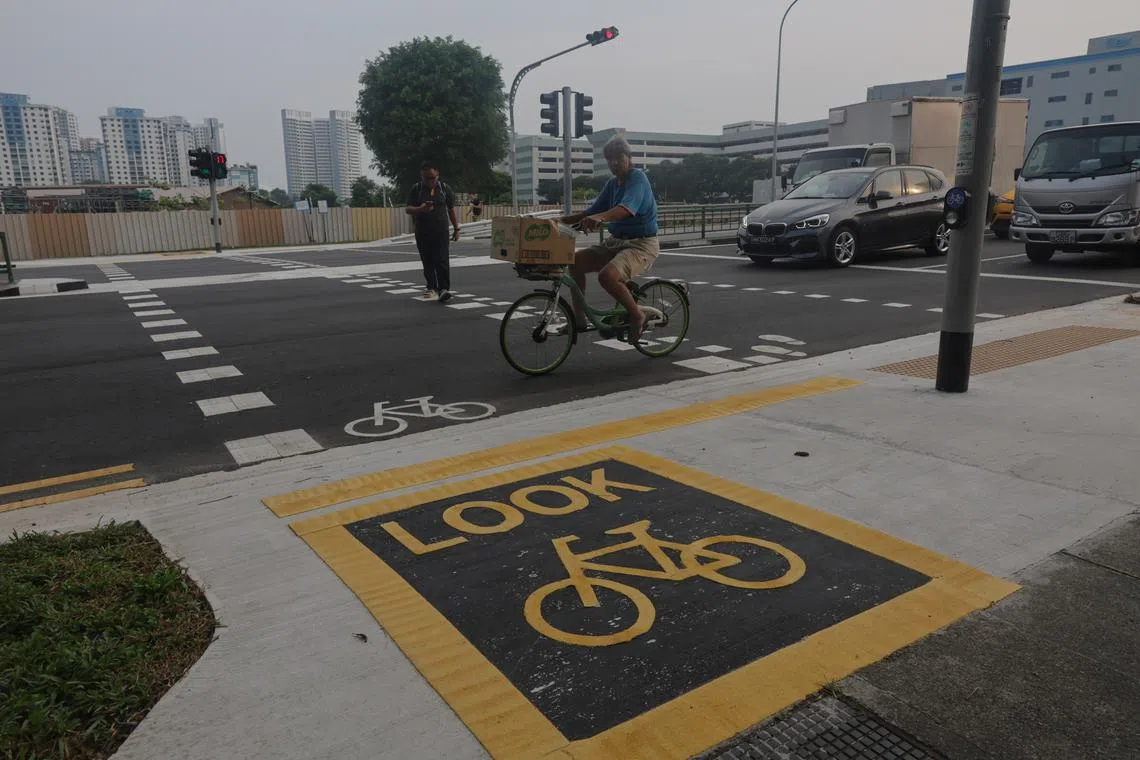Tender called to build S’pore’s longest elevated cycling bridge across PIE by 2027
Sign up now: Get ST's newsletters delivered to your inbox

An artist's impression of the future PIE Link.
PHOTO: URBAN REDEVELOPMENT AUTHORITY
Follow topic:
SINGAPORE – A 682m-long cycling bridge spanning a 14-lane section of the Pan-Island Expressway (PIE) will be built near St Andrew’s Junior School by 2027.
The Urban Redevelopment Authority (URA) on Thursday called a tender to build the bridge, which will be the longest of its kind here. It will form part of a new 1.2km link that will allow pedestrians and cyclists to travel seamlessly between the park connector next to St Andrew’s Junior College and the neighbourhood park at Jalan Taman.
Also being built will be street-level paths, a 40m-long underpass near Mar Thoma Road in Bendemeer, and a path stretching 275m from Mar Thoma Road to Jalan Taman that will hang over the Kallang River.
These works are the final piece of a larger project by URA to turn the Kallang Park Connector into a 10km-long seamless commuting route, cutting the time needed to cycle from Bishan to the Central Business District from about one to 1½ hours, to about 30 to 45 minutes.
Five other connections that form this Bishan-to-city cycling route
The works involved improvements to an underpass at the Central Expressway (CTE) near Toa Payoh Lorong 8 and another one in Geylang Road, two new underpasses in Upper Boon Keng and Kallang Bahru, as well as new street-level crossings in Serangoon Road and Bendemeer Road.
National Development Minister Desmond Lee, who officiated at the opening of these new and improved connections, said the Bishan-to-city project supports the nation’s sustainability objectives by facilitating greener commutes.
“This project has allowed us to create vibrant public spaces with the community. We also have plans to enhance residents’ access to Kallang River,” he added.
At the CTE underpass, the headroom has been increased from 1.9m to 2.4m, and more lights have been installed to brighten what was previously a dimly-lit space. Terrazzo and timber seats have been added to one side of the underpass, while a 110m-long wall mural was installed on the other side, depicting scenes of the Kallang River over the years.

At the CTE underpass, the headroom has been increased from 1.9m to 2.4m.
ST PHOTO: GIN TAY
To create a sense of place, URA said the floor beside this seating area was designed with wavy patterns and copper inlays of fish to simulate a river scene. Blue light is projected on the floor between 7pm and midnight to intensify this wavy effect.
Copper inlays of native birds and animals – such as the smooth-coated otter, white-breasted waterhen and oriental pied hornbill – also decorate the new 34m-long underpasses built in Upper Boon Keng and Kallang Bahru.
The sides of both underpasses are lined with 3D concrete murals that depict the flora and fauna found along Kallang River. Meanwhile, street-level crossings near both locations have been widened from 3m to 6m, allowing for dedicated pedestrian and bicycle crossings.

The sides of both new underpasses are lined with 3D concrete wall murals that depict the flora and fauna found along Kallang River.
ST PHOTO: GIN TAY
In Geylang Road, URA said the existing underpass has been made more inviting with a 25m-long wall mural and additional lighting.
The corner of one of the original retaining walls was reconstructed to provide a better line of sight for users, and improve ventilation and lighting in the underpass.

Wavy blue light being projected on the floor of an improved underpass at the Central Expressway near Toa Payoh Lorong 8. This light projection will last from 7pm to midnight.
ST PHOTO: KEVIN LIM
At nearby Sims Avenue, a new crossing has been added near Kallang MRT station. This reduces the distance that a cyclist or pedestrian needs to travel to cross the road there, from 390m to 70m now.
The new traffic light crossings and shared paths in Serangoon Road and Bendemeer Road also provide a more direct route for cyclists and pedestrians, URA added.

A traffic crossing in Kallang Bahru Road that has been widened from 3m to 6m to incorporate dedicated pedestrian and bicycle crossings.
ST PHOTO: GIN TAY
However, the journey there will become seamless only in the second quarter of 2024 after separate construction work that is ongoing beside Whampoa South Road is completed.
The improvements to Kallang Park Connector, built in 1992, were first proposed by URA eight years ago in 2015, and the ideas were presented to the public for feedback at an exhibition in 2017.
Various issues and options were discussed before arriving at the final blueprint, including ways to retain maximum public access to the riverfront and overcome engineering challenges.
The PIE link proved to be the most tricky. In 2020, URA said more in-depth studies and coordination were needed due to the complex nature of carrying out construction over traffic.
According to tender documents, the bridge will include 22 steel supporting columns filled with concrete, with the centre column located in the narrow centre divider of the PIE.
To the north, an elevated ramp will circle above the Kallang River, run parallel to the expressway, before connecting to the centre of the bridge. Cyclists and pedestrians will climb a height of about 14m at what URA has said is a comfortable gradient.
From the centre of the bridge, a curved ramp of the same gradient will connect to a landing point to the south of the PIE, descending about 8m.
According to the tender, there will be alcoves where people can rest – one on the bridge over the PIE and another above a promontory to the south. There will also be a 15-person lift that can fit a wheelchair and two cyclists with their bicycles.

Business owner Francis Chu, 63, who is a co-founder of recreational cycling group Love Cycling SG, said the five newly opened connections along the Bishan-to-city route will reduce commuting time and make the journey more enjoyable.
“There were a few junctions where you needed to carry your bicycle up staircases and overhead bridges. With these improvements, you can easily cycle through.”
Ms Joanna Chew, 47, who cycles around the area several times a month, said the obstructions caused by the PIE can be disruptive for cyclists who want to get into the city.
“I am really looking forward to a more seamless way to get to town. Right now, there are some parts where you have to get on the pavement or the road, and it is not so nice,” the teacher added.
Cyclist Kevin Lim, 44, is sceptical about how seamless the Bishan-to-city route will actually be.
The mechanical engineer said: “The gold standard is East Coast Park or Punggol Waterway Park, where I can cycle at about 15kmh to 18kmh for long distances relatively uninterrupted.”


